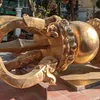Design, research, experience: How Abhishek Poddar and the Museum of Art and Photography democratise art
In our second photo essay on Bengaluru’s latest cultural attraction, we feature artistic works and founder insights.
Launched in 2014, PhotoSparks is a weekly feature from YourStory, with photographs that celebrate the spirit of creativity and innovation. In the earlier 715 posts, we featured an art festival, cartoon gallery. world music festival, telecom expo, millets fair, climate change expo, wildlife conference, startup festival, Diwali rangoli, and jazz festival.
Designed by Mathew & Ghosh, the five-storeyed Museum of Art and Photography (MAP) is at the heart of Bengaluru, within walking distance of Cubbon Park. In addition to art galleries, it hosts an auditorium, research library, education centre, and conservation facility.

Artist: G Ravinder Reddy
One of the current exhibitions at MAP is titled With great ease: The photography of TS Satyan. Other exhibitions featured in this photo essay are VISIBLE/INVISIBLE: Representation of Women in Art; and Jyoti Bhatt: Time & Time Again.
See Part I of our coverage, along with insights from Kamini Sawhney, Director, MAP. See also our earlier article on the opening of MAP in February 2023 here.
The mission of MAP is to democratise art, making it fun and relatable to everyone. It aims to get people to interact with art and develop empathy and a deeper understanding of our world.

Sculptor’s Hands, by Jyoti Bhatt
“We can get up 2,500 visitors a week. We have nine exhibitions a year,” MAP founder Abhishek Poddar tells YourStory.
“One of the galleries features four exhibitions each year, while two other galleries feature two exhibitions a year. The Sculpture Court hosts one exhibition each year,” he explains.
MAP also has digital exhibitions featured in the Sasken Multimedia Gallery. “You can have almost one exhibition each day here,” Poddar describes. These exhibitions can be customised along a number of parameters.

A Face, by Jyoti Bhatt
“We have over 60,000 works of art in our collection. Not all of them are digitised yet,” he adds. MAP hosts twelve to fifteen events a month, with varying themes and formats.
Poddar has been avidly collecting art for over three decades, and developed strong personal relationships with a range of prominent Indian artists. MAP’s Gifts Programme enables donations of artworks by other patrons and artists.
Interestingly, MAP seems to attract more youngsters than elders, which is opposite of what other museums experience. “Around 95 percent of our audience is youngsters,” he says.

Many Faces of a Face, by Jyoti Bhatt
“There were over a hundred visitors waiting for the door of the museum to open on its inaugural day,” Poddar proudly recalls. “This is something I could only have dreamt of,” he beams.
He commends the education and programming department for their impact, which he describes as “fantastic and immediate.” During one of the events featuring lullabies from around India, there were even mattresses for people to lie down on.
There are also yoga sessions in the Sculpture Courtyard on Sundays. Exhibitions on textiles and photography are very popular.

Caged Desires, by Nirmala Diluka
The advent of digital technology is impacting museums and visitors in a number of ways. MAP is using technology to help ensure its exhibitions are more accessible for people with disabilities.
“Smartphones have made everyone a photographer. It’s almost as if you can create more art in a day on your phone than you could in an entire lifetime in earlier ages,” he jokes.
“Reading has taken a hit. People are reading less lengthy articles online,” Poddar observes. “In photography, there is much more experimentation and technology involved now,” he adds.

Ardhanarashiwara
For example, there are more tools and material to blend and process. “Artists can become directors of multimedia productions much more easily and quickly,” Poddar says.
MAP’s Sculpture Court features the works of British sculptor Stephen Cox, with contemporary carvings of yoginis and rishis in basalt. The reception area has two installations by artist-designer Arik Levy.
The exhibition on Jyoti Bhatt’s photographic works addresses rural and traditional life, as well as his experimentation with a number of formats and themes. The MAP exhibition draws on an archive of over 7,000 prints and 10,000 negatives by Bhatt.

Brahmani, Mother Earth, Mariamman
The exhibition on TS Satyan features creative works of one of India’s photo-journalism pioneers. He captured historical moments while also uncovering human and emotional aspects in his subjects.
As compared to commercial galleries, museums take much longer to put together an exhibition due to the extensive nature of research involved. “It can take several months and sometimes more than a year to put together an exhibition,” Poddar explains.
MAP has a team of 15 researchers for its shows, along with designers. It also works with external consultants, and has forged fruitful partnerships with organisations such as the British Council and a number of museums in Glasgow.

Exhibition - VISIBLE/INVISIBLE
The major exhibitions also have an associated book or publication. One of MAP's outstanding publications is the Encyclopedia of Indian Art, based on which free online courses and digital content have been created.
“MAP is a platform for ideas. We exist to share the work in our collection,” Poddar says.
There are impacts beyond numbers such as the thousands of weekly visitors, according to Poddar. He signs off: “Smiles, delight, wide eyes, gratitude, grace, fun. Repeat!”
Now what have you done today to pause in your busy schedule and showcase the breadth of your creative side?

Naag, by Mrinalini Mukherjee

Exhibition - VISIBLE/INVISIBLE


Digital exhibition

Monkeys Enjoying a Ride Atop a Car, by TS Satyan

Child Labour, by TS Satyan


Museum Shop

Interactive installation



(All photographs taken by Madanmohan Rao on location at MAP.)
See also the YourStory pocketbook ‘Proverbs and Quotes for Entrepreneurs: A World of Inspiration for Startups,’ accessible as apps for Apple and Android devices.
Edited by Megha Reddy












